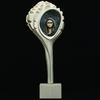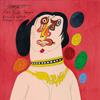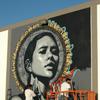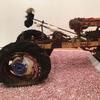Memorial Art Gallery in Rochester presents "The Path to Paradise: Judith Schaechter’s Stained-Glass Art"
- ROCHESTER, New York
- /
- October 22, 2019

Rochester, NY, October 22, 2019 — The Memorial Art Gallery (MAG) of the University of Rochester is pleased to present The Path to Paradise: Judith Schaechter’s Stained-Glass Art, the first survey and major scholarly assessment of this groundbreaking artist's 37-year career. Organized by the Memorial Art Gallery of the University of Rochester, the exhibition will be on view in Rochester from February 16 to May 24, 2020, after which it will travel to Toledo Museum of Art, June 27 to October 4, 2020, and Des Moines Art Center, February 5 to May 9, 2021.
From her start in the 1980s, Judith Schaechter (b. 1961) has stretched the medium of stained glass into an incisive art form for the twenty-first century, boldly paving her path in the diverse arena of contemporary art. With deep respect for history, a provocative rebelliousness, and a feminist sensibility, Schaechter has aptly been called a “post-punk stained-glass sorceress.” Her meticulous and awe-inspiring stained-glass panels are intentional seductions, alternative visions of beauty, and radical statements of female experience.
Drawing from both private and institutional collections, MAG will present over 40 of Judith Schaechter’s stained-glass panels along with a selection of related drawings, sketchbooks, and process materials. The exhibition and its companion publication will explore the range of critical registers Schaechter’s work spans, illuminating and contextualizing the artist’s unique contributions to the contemporary canon. The full-color, 160+page catalogue is published by RIT Press in association with the Memorial Art Gallery.
Jonathan P. Binstock, Mary W. and Donald R. Clark Director of the museum, added: “I knew such a project would be an ideal fit for MAG—an encyclopedic collection featuring five thousand years of world art—given the unique way Schaechter brings new vibrancy and relevance to the traditions of art and craft history.”
With more than 225 panels spanning her career, Schaechter has developed a singular figural style and a rich personal iconography. Her unruly female protagonists neither fit the ideal standards of beauty, nor do they comport themselves in a becoming manner, as they sometimes vomit, writhe, and commit violent crimes and sexual indiscretions. Her fantastical galaxies and pseudo-earthbound universes, rich in bizarre flora and fauna and in ever-changing states of growth and kaleidoscopic color, are all born of her imagination.
Schaechter’s respect for the traditional medium of stained glass is matched by her drive to innovate. She is well versed in the historic techniques of stained glass, however, her panels—hung from the wall in custom-made light boxes—are contemporary art forms that stand alone. With artistic influences as wide-ranging as pulp fiction covers, neuroscience, Northern Renaissance masters, MAD magazine, ancient mythology, and medieval manuscripts, Schaechter’s work calls for a process that is equally diverse, incorporating online image sourcing, intensive doodling, Photoshop acrobatics, and her innovative, masterful manipulation of glass. She said she thinks of her practice “as an extreme sport. I’m not messing around. I deliberately make it as hard as possible. . . .”
Schaechter’s work is represented in over a dozen museums including the Carnegie Museum of Art, Corning Museum of Glass, Mint Museum, Museum of Arts and Design, Pennsylvania Academy of the Fine Arts, Philadelphia Museum of Art, Renwick Gallery of the Smithsonian American Art Museum, Speed Art Museum, and Toledo Museum of Art, and in major exhibitions around the world. In addition, through her extensive teaching, she has had a sizable impact upon her peers and the next generations of artists. Her awards include two NEA Visual Artists’ Fellowships, a Louis Comfort Tiffany Foundation Award, a Joan Mitchell Foundation Painters and Sculptors Grant, a Guggenheim Fellowship, a USA Artists Fellowship, and an American Craft Council College of Fellows Award.
Jessica Marten, Curator in Charge/Curator of American Art at MAG, remarked: “This project is long overdue. Schaechter, whose earliest work in this exhibition was made in 1983, stands with pioneers like Faith Ringgold and Miriam Schapiro in questioning the binary and often gendered divisions between art and craft, formalism and the decorative, and masculine and feminine. Her contributions and transgressions are distinctly American, feminist interventions into the history of contemporary art, craft, and the medium of stained glass.”
Schaechter’s provocations express her punk rebellion against the status quo, and they normalize the nuances of female sexuality, a topic still fraught today. In his introduction to the catalogue, noted scholar Glenn Adamson celebrates the artist’s “comic grotesqueries…infused with a degree of heavenly grace.” Adamson continues, “She does not turn her eyes away from the very worst of human nature. Schaechter must be the only stained-glass artist in history whose work warrants trigger warnings.”
Programming centered around the exhibition will take place throughut the run of the show, including a lecture by Judith Schaecter at the Memorial Art Gallery on the opening day at 1 pm. Prior to the opening at MAG, a solo exhibition featuring a selection of Schaecter’s work will be on view at the Claire Oliver Gallery in Harlem, New York for a 6 week period beginning on January 17, 2020.
Lead support is provided by the Henry Luce Foundation, with additional funding from the Gallery Council of the Memorial Art Gallery, Pamela Miller Ness and Paul Marc Ness, Corning Incorporated Foundation, the Art Alliance for Contemporary Glass, James C. and Geraldine Biddle Moore, and Elizabeth L. Stauderman. The exhibition is also supported in part by an award from the National Endowment for the Arts.
The exhibition is also made possible by the Margaret Davis Friedlich and Alan and Sylvia Davis Memorial Fund, the Robert A. and Maureen S. Dobies Endowment Fund, the Irving and Essie Germanow Fund, the Grant Holcomb Endowment, the Kayser Fund, the Elizabeth and Eric Rennert Family Fund, the Robert L. and Mary L. Sproull Fund, and other donors.
About The Memorial Art Gallery
The Memorial Art Gallery showcases visual art from antiquity to the present day, including an outdoor public Centennial Sculpture Park. In addition to its permanent collection, MAG offers a year-round schedule of special exhibitions, lectures, concerts, tours, after-hours social events, and family activities.
Hours: Wednesday–Sunday 11 am to 5 pm, and until 9 pm on Thursdays and select Fridays. Closed Mondays and Tuesdays. Admission: $15; seniors, $12; college students with ID and children 6–18, $6. Always free to members, University of Rochester faculty/staff and students, and children 5 and under. Half-price general admission Thursdays from 5–9 pm is made possible in part by Monroe County. For more information, call 585.276.8900 or visit mag.rochester.edu.
###
Press contact: Meg Colombo (585) 276-8934 / mcolombo@mag.rochester.edu or
Bow Bridge Communications: Libby Mark or Heather Meltzer (347) 460-5566 / info@bow-bridge.com
MAG Contact: Rachael Brown, Director of Marketing and Engagement (585) 276-8937 / rbrown@mag.rochester.edu
Contact:
Libby Mark or Heather MeltzerBow Bridge Communications
347-460-5566
info@bow-bridge.com
500 University Ave.
Rochester, New York
maginfo@mag.rochester.edu
(585) 276-8900
https://mag.rochester.edu












![Peter Paul Rubens (Flemish, 1577–1640), After Titian (Tiziano Vecelli) (Italian [Venetian], c. 1488–1576), Rape of Europa, 1628–29. Oil on canvas, 71 7/8 x 79 3/8 in. Peter Paul Rubens (Flemish, 1577–1640), After Titian (Tiziano Vecelli) (Italian [Venetian], c. 1488–1576), Rape of Europa, 1628–29. Oil on canvas, 71 7/8 x 79 3/8 in.](/images/c/e2/2e/Jan20_Rape_of_Europa100x100_c.jpg)



